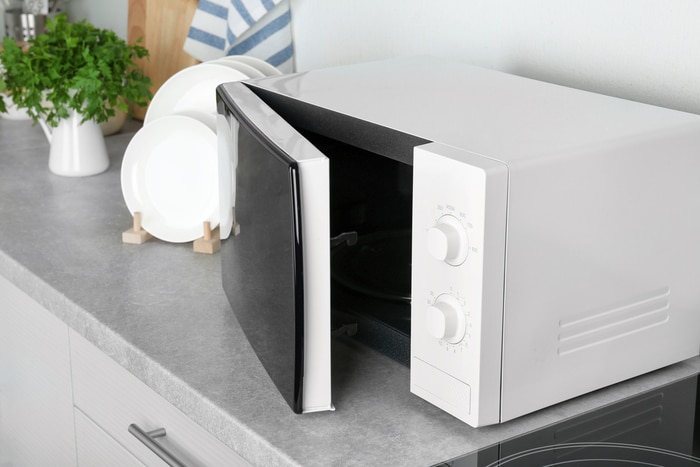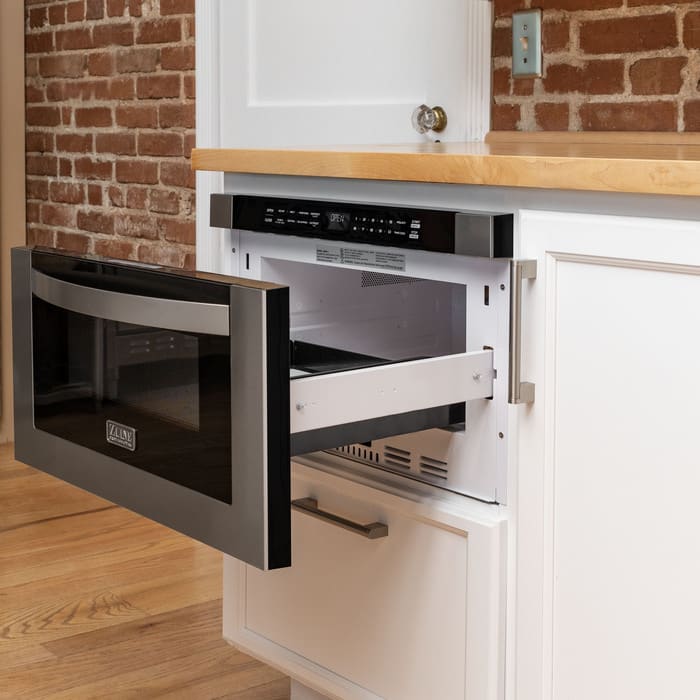We've independently reviewed this article to make sure it's as accurate as we can make it.
To find out more about our article creation and review process, check out our editorial guidelines.
Do you want to buy a new microwave but are unsure what to look for?
You’re not alone! It’s very common to struggle when looking for the best microwave to buy.
Americans spend more than 1.8 billion dollars on this appliance each year. So, with many options available, buying the right microwave can feel a bit overwhelming.
After all, some microwaves can be a bit pricey, so I’m sure you want to invest your money wisely and avoid being stuck with cold food or other annoying issues.
Don’t worry – I’m here to help! I’ve spent over seven years repairing and covering all sorts of appliances, and I’m excited to share all my tips for finding the perfect microwave.
In this article, you’ll learn about the different types of microwaves and what factors you should consider when buying one. I’ll also give you tips on which features to look for (and which ones to avoid) and answer your most common questions about buying a microwave.
Read on to buy the microwave that’s just right for you!
Why trust us? This article was written by Craig Anderson and James Blackford.
Craig has helped thousands of other homeowners repair their appliances since 2016. James is one of our resident appliance experts with over 16 years of experience. He currently works as a Master Technician for SquareTrade, and runs his own appliance repair business.
Types of Microwaves
My usual advice for homeowners looking to buy a new microwave is to consider its type.
Keep in mind that it’s not only the design that can differ between microwaves. Their features and functionality can also vary quite a bit, which can impact your final buying decision.
The five main types of microwaves are:
Countertop Microwave
If you want to buy a microwave that is easy to install, I recommend considering a countertop microwave.
Countertop microwaves are the standard models commonly seen everywhere around the world. No installation is required – just plug in and get cooking!

Countertop microwaves are very easy to move. They are also great if you’re on a budget, as they are more affordable than other models.
Even though a countertop model is the cheapest microwave type, you can still find some great options packed with amazing features, giving you great value for your money.
Over-The-Range Microwaves
Over-the-range microwaves are intended to “blend in” as they are installed above your range, so you can keep your valuable counter space clear.
They also act as a vent, eliminating smoke and steam from the range below.
In my opinion, the venting will never be as good as a dedicated hood, but it can help improve air quality in your kitchen.

Bear in mind that it can be hard for everyone at home to reach an over-the-range microwave. These types of microwaves can also be dangerous when handling hot food.
Built-In Microwaves
If you’re like me and want to create a stylish modern kitchen, you should consider buying a built-in microwave.
Built-in microwaves are installed straight into your cabinet space or even onto a shelf on the wall. They’re also ideal for smaller kitchens where space is very valuable.

Bear in mind that built-in microwaves usually come with more features than other types of microwaves, so their price tag can be a bit higher.
Microwave Drawers
Microwave drawers are also known as “under-counter microwaves” and are embedded into kitchen cabinets as drawers.

Removing or adding heavy objects is much easier with drawer microwaves because they’re typically installed at waist height, which is great news for anyone who is a bit shorter or physically impaired.
Drawer microwaves have a sleek design and modern features. They are also great if you have limited space in your kitchen. Just keep in mind that they can be more expensive than other types of microwaves.
Convection Microwaves
I recommend considering a convection model if you want to buy a versatile microwave.
Convection microwaves aren’t just for heating your food; they can also act as a regular oven by letting you bake, broil, and roast food.
Keep in mind that the convection cooking feature can be available in any microwave type. Whether you prefer a countertop model, a drawer option, or even a built-in or over-the-range style.
Convection microwaves have a standard heating element – with fans to move the roasting hot air around like a conventional fan oven.
In my opinion, convection microwaves are fantastic for smaller kitchens as a 2-in-1 appliance or if you also want a second, smaller oven to tackle quick bakes and side dishes. (Remember, it needs to be pre-heated, too!)
When buying a convection microwave, keep in mind that it can be more expensive than other models due to its design and multiple features.
Microwave Buying Considerations
There are different factors you need to keep in mind when choosing a microwave. That’s why I’ve prepared this quick buying guide to help you make an informed decision.
#1 Kitchen Layout
I always advise homeowners to consider their kitchen space and layout when buying a new microwave, as this will determine the type of model required.
For example, if you’re like me and have limited counter space, you’ll need a microwave that can be embedded or mounted under a cabinet.
It’s also important to think about your kitchen style. If you have a modern and trendy kitchen, a built-in or drawer microwave is the way to go.
Once you’ve thought about the layout and style of your kitchen, it’s time to measure the space where you plan to put your microwave to make sure it fits perfectly.

To do it, you’ll need to grab a measuring tape, write down the area’s height, width, and depth, and refer to these measurements when browsing for a microwave.
Don’t forget to keep in mind the installation requirements. Some microwaves, such as over-the-range, drawer, or built-in units, can be more complicated to install (compared to countertop microwaves).
#2 Size & Capacity
It’s also important to think about the size and capacity of a microwave to make sure it meets your food needs and fits perfectly in the area you previously measured.
Microwaves typically come in three sizes: small, standard, and large. When choosing the perfect microwave size, you need to think about your family size and how you plan to use it.
For example, if you have a large family or often have friends over, my advice is to get a large microwave.
Check the following microwave size guide to make the right choice:
| Small (0.5 – 0.9 cubic feet) | Standard (1.0 – 1.6 cubic feet) | Large (1.7 + cubic feet) | |
| Usage | Minimal cooking needs, such as simple reheating leftovers or defrosting. | Cooking, reheating, and defrosting larger dishes, such as casseroles. | Extensive cooking needs, such as cooking whole turkeys or multiple dishes at once. |
| Family size | 1-2 | 2-4 | 4+ |
Bear in mind that the size and capacity of a microwave will vary depending on its type. The chart provided above is meant to be a general reference.
When buying a microwave, please keep in mind that it needs some breathing room to prevent heat buildup and make sure the unit works correctly.
I recommend leaving at least 3 inches (7.6 cm) of space behind and on each side of the microwave and avoid placing things on top to prevent any safety hazards.
#3 Features
When buying a new microwave, you’ll come across different features, which can complicate the purchase decision.
Don’t worry, though. I’ve tested all the available microwave features to help you decide which ones are worth the investment and which ones you can pass on.
The features I recommend looking for when buying a new microwave are:
- Sensor cooking: This feature senses moisture and humidity levels emitted from your food and automatically adjusts the cooking time for the best results. It also helps you save money on your energy bills!
- Tray or turntable: The microwave turntable is a rotating glass plate that helps to ensure your food is evenly heated. Although the turntable is a common feature, I recommend double-checking that the microwave you plan to buy has it. Trust me; you don’t want to be stuck with cold food!
- Auto Defrost: The defrost feature automatically adjusts the microwave’s power to defrost your food without cooking, which is handy when you’re in a hurry. Bear in mind that you should always cook your food immediately after thawing it in the microwave to avoid health issues.
- Steam cooking: If you don’t own a food steamer, the steam cooking feature will be your best friend, as you can easily prepare vegetables, rice, fish, and even eggs.
- Child lock: The control panel will automatically lock if you enable the child lock. This way, you’ll keep your kids from accidentally pressing any buttons.
- Quick controls: The shortcut keys allow you to prepare a specific food, such as popcorn or leftovers, with just the touch of a button, so you don’t have to guess how long to heat something.
Now that you know the best features to look for when buying a new microwave, it’s time to talk about the ones you can skip.
Some modern microwaves connect to your Wi-Fi network and other smart devices, allowing you to control them through your phone (some even have voice recognition!).
Although Wi-Fi connectivity may sound appealing to some people, I believe that it can be a waste of your hard-earned money. There are great microwaves available without the added cost of this technology.
There are also some microwaves that have a self-cleaning feature, which can be handy if you have a big family or a convection microwave. But, if that’s not the case, you can save some extra money and clean it yourself.
#4 Wattage
When choosing a microwave, you also need to consider its wattage, as this affects how quickly and evenly your food cooks.
According to Energy Sage, microwaves use about 600 to 1000 watts on average. However, some models (like those used in restaurants) can have up to 1200 watts.
The higher the microwave wattage, the faster and more evenly your food will cook.
If you’re looking for an effective microwave, I recommend looking for one between 800 and 1000 watts, so you won’t have to worry about cold spots ruining your meal.
#5 Price
Whether you’re replacing your current microwave or you’re a first-time buyer, I’m sure you want to get the most out of your budget.
Microwaves prices can vary depending on their type, features, brand, and design. From what I’ve seen, some models cost $100, while others can reach up to $3100! But the average is usually around $500.

If you have a tight budget, a countertop microwave is the way to go, as this model is lighter, cheaper, and more affordable than other types of microwaves.
On the other hand, drawer microwaves are typically the most expensive models due to their technology, features, materials, and design.
#6 Warranty
One of the most important things you need to consider when buying a microwave is its warranty.
Based on my experience, calling a certified electrician or appliance repair expert to inspect your microwave can cost over $220!
So, if your microwave is under warranty, you can ask for a refund or free repairs.
Microwaves can last up to 10 years if well-maintained. Unfortunately, the industry-standard warranty length for these appliances is one year.
The good news is that manufacturers usually offer extended warranties or protection plans for an additional cost.

I recommend getting an extended warranty or protection plan if you’re planning on investing a lot of money in your new microwave.
To check the warranty of a microwave, you can go to the manufacturer’s website or ask the retailer.
#7 Reputable Brand
The final aspect to consider in this microwave buying guide is the brand choice.
When it comes to microwaves (and any other appliance), brands have different levels of quality and value.
Although there’s very little difference between the internal parts of a microwave, some of my favorite brands are Samsung and Whirlpool, as they offer various models with useful features at a reasonable price.
Click here to take a look at our microwave brand comparison and make the right choice!
That being said, there are smaller companies out there that are absolute gems. For those cases, it’s worth going and checking out their website and company profile to get an idea if they’re authentic or not.
Choosing Your Microwave
Now that you’ve read this microwave buying guide, it’s time to make a decision.
Keep in mind that there is no one-size-fits-all answer when it comes to buying a new microwave. The decision will depend entirely on your needs and preferences.
I recommend prioritizing the tips we’ve provided in this microwave buyer’s guide. Start by thinking about what you need in a microwave. Do you want to save countertop space? Are you looking for an option that offers the latest features? Or are you concerned about the heating performance?
For example, if you want your kitchen to look stylish and don’t mind splurging a little, consider buying a built-in or drawer microwave.
Or, if you have limited space and don’t own an oven, you’ll likely benefit from a convection microwave that can be embedded. But, if you have a tight budget and enough counter space, I recommend getting a countertop microwave.
Once you’ve identified your priorities, search for different brands and models. Don’t forget to keep in mind the size, kitchen layout, wattage, reviews, price, and features.
Frequently Asked Questions
How Many Years Does a Microwave Usually Last?
The lifespan of your microwave will depend entirely on how frequently it’s used, how well it’s maintained, and the brand. For instance, a microwave that is used for normal cooking and is well-maintained can last up to 10 years.
But, if a large family uses a microwave frequently and it is not maintained properly, it can last around four years.
What Are the Signs That a Microwave Is Going Bad?
If your microwave takes longer than usual to heat your food or makes weird sounds as it operates, you’ll need to repair or replace it. A burning smell or a broken door can also indicate damage to the appliance.
If you notice any of these issues or experience a different one, please take action right away to prevent any safety concerns.
Is 900 Watts Enough for a Microwave?
As you learned in this microwave buyer’s guide, the wattage indicates the cooking power of your microwave and affects how quickly your food cooks.
A 900-watt microwave is typically powerful enough for most families and everyday tasks, such as reheating leftover foods.







